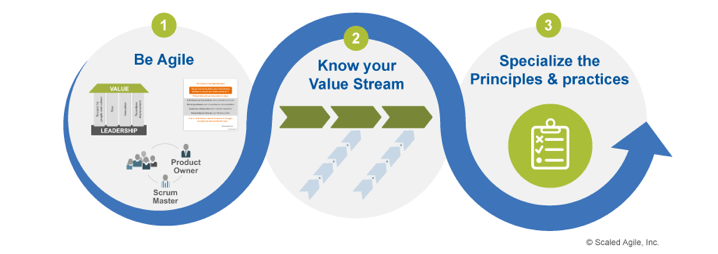Leadership Myths - Part 2
In part 1 of our two-part series on Agile Leadership Myths, we busted three of the more common tales we have seen prevalent in organizations. Today, we’ll look at three more of these tales of tradition and put them to the test.
Myth 4: Self-Organizing teams require hands-off leadership
How often have we heard the phrase, “Leave it to the team,” or “The team is empowered to do whatever it wants”? My favorite is, “Leaders need to set the direction and get the heck out of the way.”
These catchphrases sound supportive, but they lull us into a false sense of security by simply uttering “you are empowered,” and giving full permissions means teams no longer need leadership help and guidance. We want to enable self-organizing empowered teams. However, the need for quality leadership doesn’t evaporate because we give teams autonomy and decision-making authority. Impactful agile leadership is still required, AND… it’s a full-time job!
Shift to process improvement and people development!
Shift away from task management, directing work details, and firefighting. Empowered self-organizing teams with the right competencies, skills, and experience must do that themselves. Focus your efforts on process improvement and people development!
Impactful Agile Leadership Behaviors:
- Articulating strategy clearly and powerfully using measurable outcomes
- Setting and maintaining a clear list of priorities
- Relentlessly pursuing continuous improvement
- Removing obstacles outside the team’s control
- Decentralizing decision making to the lowest possible levels
- Building and nurturing a healthy culture of values and norms
- Investing in individuals’ growth and development
Myth 5: Leaders must be subject matters experts
Many managers, directors, and vice presidents get promoted because of their expert knowledge. They may have even held the unofficial title of “smartest person in the room” amongst their peers. Who wants to let go of that?
And yet we all know the most knowledgeable individual contributors don’t always make the best people leaders. Leadership requires different training, skills, and competencies that transcend being a subject matter expert and a rock star individual contributor.
No leadership book recommends you must know more than the people you lead.

Now there is nothing wrong with pursuing mastery. Renowned author Daniel Pink’s research in his now legendary book “Drive”, reveals that mastery is one of three core elements of motivation. But a requirement that leaders possess superior subject matter expertise and greater than those under their leadership is a myth to bust.
Let’s look at some unhealthy behaviors around subject matter expertise and alternatives for healthy behaviors.
|
Unhealthy |
Healthy |
|
As “the” expert, I can better solve the teams’ problems. |
I can use my knowledge to ask questions that invoke the team to find their own answers. |
|
As “the” expert, I must solution for the team. |
I can transfer my knowledge to others and challenge them to experiment with their ideas. |
|
I need to maintain knowledge superiority for the team to respect me as a leader. |
I will work to disidentify myself with the need to be the smartest and embrace mastering the competencies of leadership. |
Myth 6: "Don't do agile, be agile": Lead with culture first
It’s a very Zen mantra, but without the incense and gong. I bought into this myth early in my career with the utmost good intentions. Upon reflection, the statement lacks substance and fails to recognize the rest of the equation.
The premise is that we can’t “process” our way to success without first embracing the new world order of agile thinking. It’s as if to say we must start and anchor our transformation by changing our mindset to the ways of agile thinking.
We hypothesize that if I can get you to think agile, all the improvements will come.
If I can get you to think differently than you are used to, it will be easy to get the right behaviors to follow, whereby all system improvements will flow from that. This has never been the case in my experience.
Folks may be saying the right things, possibly even improving behaviors. Yet without proper guidance on what it takes to form high-performing delivery teams, manage the flow of work with prioritized backlogs, and create working increments of software, people’s tolerance for anything agile will quickly sour or even turn anti-agile.
I’m not railing against the mindsets of being agile. They’re all essential. However, “being agile” alone and starting an agile transformation focusing only on changing mindset will not bring about the desired outcomes you expect to achieve.
No amount of mindset can make up for missing information on how to execute.
Be and do agile simultaneously! Striking the right balance of doing, learning, reflecting, while embracing agile ways of thinking will lead to the desired behavioral changes and take your transformation results to the next level.

Final Thoughts
The myths we touched on in our two-part series represent a sampling of the more common beliefs that have found their way into our thinking. While we have all good intentions, it is easy to buy into the narratives. We all do it. Staying anchored to sound leadership principles and practices is crucial.
To ensure leaders are developing the desired competencies and behaviors that keep us firmly rooted in truth, we recommend adopting a learn, measure, and growth strategy that invests in the continuous development of leaders at all layers of the organization.
Getting Started
- Learn with AgilityHealth’s Talent Development Jump Start
- Measure and Grow using the Leadership Agility Radar
- Contact the AgilityHealth team here to get started!



Comments